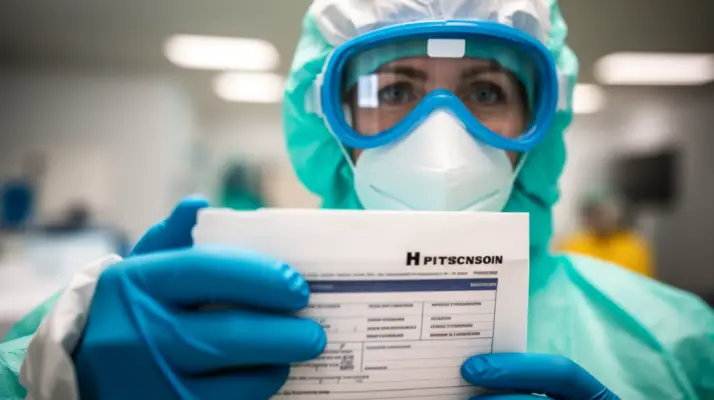This article provides a comprehensive overview of the TB Risk Assessment Form in Missouri, focusing on its background, purpose, and guidelines set forth by the Missouri Department of Health and Senior Services (DHSS).
The article aims to elucidate the importance and benefits of completing this form, which is crucial in assessing the risk of tuberculosis (TB) within the state.
Adhering to the DHSS guidelines, individuals and healthcare professionals can effectively identify and manage TB cases, thus contributing to Missouri’s public health efforts.
Background on TB Risk Assessment
This article aims to provide an overview of the purpose of TB risk assessment forms in Missouri.
It will explore the significance of these forms in identifying individuals at high risk of tuberculosis infection and guiding appropriate preventive measures.
The discussion will also delve into the specific components of the risk assessment form and how they contribute to a comprehensive evaluation of TB risk.

Purpose of the Article
The article aims to provide a comprehensive overview of Missouri’s tuberculosis risk assessment form.
Tuberculosis (TB) is a bacterial infection that primarily affects the lungs and can be spread through the air from person to person.
Healthcare workers are at a higher risk of contracting TB due to their frequent contact with individuals who may have the disease. Therefore, healthcare providers must conduct thorough risk assessments and implement appropriate screening measures.
Missouri’s TB risk assessment form plays a vital role in this process. It collects information about an individual’s exposure to TB, symptoms, and previous chest X-ray results. This form aids in identifying individuals who may require further testing or treatment for TB and provides documentation of the screening process for healthcare providers.
Using Missouri’s TB risk assessment form facilitates effective tuberculosis screening and ensures proper process documentation.
Understanding Tuberculosis
This discussion focuses on understanding tuberculosis (TB) by exploring its definition, causes, symptoms, risk factors for contracting the disease, and prevention and treatment measures.
TB is a contagious bacterial infection caused by Mycobacterium tuberculosis. It primarily affects the lungs but can also affect other body parts, such as the kidneys and spine.
Definition and Causes
The definition and causes of tuberculosis (TB) can be understood by examining its clinical characteristics and the factors contributing to its transmission.
TB is a bacterial infection caused by Mycobacterium tuberculosis. It primarily affects the lungs but can also affect other parts of the body such as the skin, bones, and chest.
TB transmission occurs through inhaling respiratory droplets containing the bacteria, typically when an infected individual coughs or sneezes.
Factors contributing to the spread of TB include overcrowded living conditions, poor ventilation, and close contact with individuals with active TB disease.
It is important for individuals at risk to undergo tuberculosis testing and complete a tuberculosis risk assessment screening form, which healthcare providers or student health services can provide.
The screening form helps identify individuals who may require further evaluation based on their exposure, symptoms, and tuberculosis testing records.
Symptoms of TB
Tuberculosis (TB) symptoms can manifest in various parts of the body, such as the lungs, skin, bones, and chest.
In the lungs, TB symptoms often include persistent coughing, chest pain, and coughing up blood or phlegm.
Skin symptoms may present as ulcers, boils, or rashes.
Bone TB can result in joint pain, spinal deformities, and restricted movement.
Chest symptoms may include difficulty breathing, wheezing, and chest tightness.
Other general symptoms of TB can include fatigue, night sweats, weight loss, and fever.
It is important to note that TB symptoms may vary depending on the individual and the stage of the disease.
Prompt diagnosis and treatment are crucial to prevent the spread of TB and its potential complications.
Risk Factors for Contracting TB
Risk factors associated with the transmission of tuberculosis (TB) include:
- Close contact with individuals infected with Mycobacterium tuberculosis.
- Compromised immune system.
- Overcrowded living conditions.
- Inadequate access to healthcare facilities.
Close contact with TB-infected individuals is a significant risk factor for contracting the disease, as the bacteria can be spread through respiratory droplets.
Individuals with compromised immune systems, such as HIV/AIDS or undergoing certain medical treatments, are also at higher risk.
Overcrowded living conditions, often found in densely populated areas or low-income countries, can facilitate the spread of TB.
Inadequate access to healthcare facilities further increases the risk, as timely diagnosis and treatment are crucial in preventing the transmission of TB.
It is important for health departments and residential healthcare facilities to be aware of these tuberculosis exposure risk factors and implement appropriate measures to mitigate the spread of the disease.
Prevention and Treatment of TB
Prevention and treatment strategies for tuberculosis (TB) involve a combination of early diagnosis, appropriate drug therapy, and adherence to infection control practices. These measures play a crucial role in reducing the transmission and burden of TB.
To evoke emotion in the audience, it is important to highlight the potential consequences of not implementing these strategies effectively:
- Failure to diagnose TB early can lead to delayed treatment initiation, which increases the risk of disease progression, complications, and transmission.
- Inadequate drug therapy can result in treatment failure, drug resistance, and the need for more complex and costly treatment regimens.
- Poor adherence to infection control practices can lead to outbreaks within healthcare settings, putting patients and healthcare workers at risk.
Therefore, it is imperative to prioritize early diagnosis, appropriate drug therapy, and strict adherence to infection control practices to prevent and treat TB effectively.
Missouri Department of Health and Senior Services (DHSS) Guidelines for TB Risk Assessment Forms
This discussion will provide an overview of the guidelines established by the Missouri Department of Health and Senior Services (DHSS) for TB Risk Assessment Forms.
The guidelines outline specific requirements regarding completing these forms, ensuring consistency and accuracy in data collection.
Additionally, the discussion will delve into the data collection procedures for TB Risk Assessment Forms in Missouri, highlighting the systematic approach employed by DHSS to gather information on tuberculosis risk factors.

Overview of DHSS Guidelines
According to the DHSS guidelines, the risk assessment form for tuberculosis in Missouri provides an overview of the recommended procedures and protocols.
The form, also known as Form MO, is designed to assess the risk of tuberculosis transmission and guide appropriate testing and treatment measures. It includes sections to collect information on the individual’s demographic details, medical history, and potential exposure to tuberculosis.
The form also addresses health privacy laws and emphasizes the importance of confidentiality in handling sensitive medical information.
The purpose of the form is to facilitate the implementation of the tuberculosis testing program and ensure compliance with the tuberculosis testing requirements set by the Missouri Department of Health and Senior Services.
Using this form, Magers Health and Wellness Center and other healthcare providers can effectively assess the risk of tuberculosis incidence and take necessary precautions to protect public health.
- Sub-list 1:
- Ensures accuracy and consistency in the risk assessment process
- Facilitates communication between healthcare providers and public health department
- Sub-list 2:
- Raises awareness about tuberculosis transmission and prevention
- Encourages early detection and treatment for individuals at risk
Specific Requirements Regarding Completion of Forms
The specific requirements regarding the completion of the risk assessment form for tuberculosis in Missouri are designed to ensure standardized and accurate data collection for effective communication between healthcare providers and the public health department.
These requirements are crucial in identifying individuals at risk of active tuberculosis disease and facilitating prompt diagnosis and treatment.
The risk assessment form consists of several sections, including a symptom assessment, screening for tuberculosis, and documentation on file. Licensed healthcare providers must complete the form thoroughly, providing detailed information on the patient’s symptoms, exposure history, and any previous diagnosis of tuberculosis.
Additionally, the form includes a section for the treatment nurse to document the prescribed antibiotic treatment and any additional documentation required for the patient’s case.
Adhering to these specific requirements, healthcare providers can ensure that accurate and comprehensive information is collected, allowing for effective surveillance and control of tuberculosis in Missouri.
| Section | Description |
|---|---|
| Recording the prescribed antibiotic treatment for tuberculosis and any additional documentation required for the patient’s case. | Evaluation of the patient’s symptoms related to tuberculosis, including cough, fever, night sweats, and weight loss. |
| Screening for Tuberculosis | Assessment of the patient’s risk factors and exposure history, such as close contact with individuals diagnosed with tuberculosis or travel to high-risk areas. |
| Documentation on File | Verify the patient’s previous diagnosis of tuberculosis, if applicable, and document any additional tests or treatments received. |
| Treatment Nurse Documentation | Recording of the prescribed antibiotic treatment for tuberculosis and any additional documentation required for the patient’s case. |
Data Collection Procedures for TB Risk Assessment Forms in Missouri
- To ensure standardized and accurate data collection, the data collection procedures for tuberculosis risk assessment forms in Missouri involve thoroughly completing symptom assessment, screening, and documentation sections.
- These procedures aim to gather comprehensive information about individuals at risk of tuberculosis and identify any potential cases of tuberculosis bacteria.
- The forms are regularly updated to reflect the latest guidelines and best practices in tuberculosis screening and prevention.
- Completing sections related to negative skin testing, positive skin testing, and other forms of skin testing is crucial for identifying individuals who may require further testing or treatment.
- Proper documentation is emphasized to ensure that all relevant information is recorded accurately and can be used for future reference or analysis.
- Additionally, individuals who are identified as at risk may be re-tested periodically to monitor their tuberculosis status.
- The form also includes a list of countries with a high prevalence of tuberculosis to help identify individuals who may have been exposed to the disease while travelling or living abroad.
Benefits of Completing a TB Risk Assessment Form in Missouri
This focuses on the benefits of completing a TB Risk Assessment Form in Missouri.
Completing this form can lead to improved public health outcomes. It allows for identifying and tracking individuals at risk for tuberculosis (TB), leading to timely interventions and preventive measures.
Furthermore, completing the form ensures enhanced safety measures for campus students and healthcare workers. It enables the identification and appropriate management of individuals with TB, reducing the risk of transmission in these settings.
Lastly, early diagnosis and treatment facilitated by completing the TB Risk Assessment Form can result in significant cost savings. It prevents the progression of TB to more severe stages and reduces the need for extensive treatments.
Improved Public Health Outcomes
Enhanced public health outcomes can be observed due to implementing of improved risk assessment forms for tuberculosis (TB) in Missouri. Introducing these forms, such as the TB Risk Assessment Form in Missouri, has positively impacted public health.
- Sub-list 1: Emotional impact
- Increased peace of mind for individuals who have completed the risk assessment form and received a negative result, reducing anxiety and fear of having active or infectious tuberculosis.
- Improved confidence in the healthcare system and its ability to effectively identify and treat TB cases, leading to a sense of security within the community.
- Sub-list 2: Treatment and support impact
- Enhanced support for individuals who test positive for TB, as the risk assessment form helps promptly refer them to a certified healthcare provider and a treatment clinic.
- Increased access to helpful medication treatment and support services, leading to improved health outcomes and a reduced risk of TB transmission within the community.
Enhanced Safety Measures for Campus Students and Healthcare Workers
Safety measures for campus students and healthcare workers have been shown to enhance overall well-being and minimize the risk of potential harm. In the context of Tuberculosis (TB) risk assessment, these measures play a crucial role in preventing the transmission of the disease.
One such measure is the utilization of the TB Risk Assessment Form Missouri, which helps identify individuals at higher risk and ensures appropriate interventions are implemented. Additionally, enhanced safety measures in healthcare settings, such as Walgreens health clinics, include regular screenings using skin tuberculin tests.
This allows for early detection and treatment of TB in healthcare workers, reducing the risk of transmission to staff and patients. By implementing these measures, the risk of TB transmission can be effectively managed, promoting a safer environment for campus students and healthcare workers.
| Safety Measure | Implementation |
|---|---|
| TB Risk Assessment Form Missouri | Identifying high-risk individuals |
| Regular screenings using skin tuberculin tests | Early detection and treatment |
| Enhanced safety measures in healthcare settings | Minimizing transmission risk |
Keywords: tb risk assessment from Missouri, enhanced safety measures, campus students, healthcare workers, Walgreens health clinics, skin tuberculin, untreated people, country of birth, current semester, subsequent semester.
Cost Savings with Early Diagnosis and Treatment
Early diagnosis and treatment of tuberculosis can lead to significant cost savings in healthcare systems. This is particularly important considering the socioeconomic burden of tuberculosis, which affects vulnerable populations such as homeless persons.
Timely identification of tuberculosis cases through methods like tuberculin skin testing can help prevent the spread of the disease and reduce the overall healthcare costs associated with prolonged and intensive treatment. Additionally, early intervention can prevent complications and reduce the need for expensive hospitalizations.
Frequently Asked Questions
What Is the History of Tuberculosis in Missouri?
The history of tuberculosis in Missouri is a subject of academic interest. It involves the study of past occurrences of tuberculosis in the state, including its spread, impact on public health, and efforts to control and prevent its transmission.
What Are the Symptoms of Tuberculosis?
The symptoms of tuberculosis include persistent cough, chest pain, fatigue, weight loss, night sweats, and fever. These symptoms may vary depending on the stage of the disease and can be accompanied by other complications.
How Is Tuberculosis Diagnosed?
Diagnosing tuberculosis involves a combination of medical history, physical examination, and diagnostic tests such as tuberculin skin test, blood tests, chest X-ray, and sputum tests. These methods help to confirm the presence of the disease.
Are There Any Specific Guidelines or Criteria for Completing a TB Risk Assessment Form in Missouri?
Specific guidelines or criteria for completing a TB risk assessment form in Missouri are available. These guidelines aim to assess an individual’s risk for tuberculosis and aid in determining appropriate testing and treatment measures.
How Long Does It Take to Receive the Results of a TB Risk Assessment Form in Missouri?
The time it takes to receive the results of a TB risk assessment form in Missouri varies depending on several factors, such as the workload of the facility processing the form and the completeness of the information provided on the form.

Conclusion
In conclusion, completing a TB risk assessment form in Missouri is crucial for identifying individuals at risk for tuberculosis and implementing appropriate preventive measures.
The Missouri Department of Health and Senior Services guidelines ensure a systematic approach to assessing TB risk factors.
Healthcare professionals can effectively identify and manage individuals with TB infection or disease by understanding the background and significance of TB risk assessment.
This comprehensive approach ultimately contributes to the overall goal of preventing the spread of tuberculosis in Missouri.

Chris Ekai is a Risk Management expert with over 10 years of experience in the field. He has a Master’s(MSc) degree in Risk Management from University of Portsmouth and is a CPA and Finance professional. He currently works as a Content Manager at Risk Publishing, writing about Enterprise Risk Management, Business Continuity Management and Project Management.

